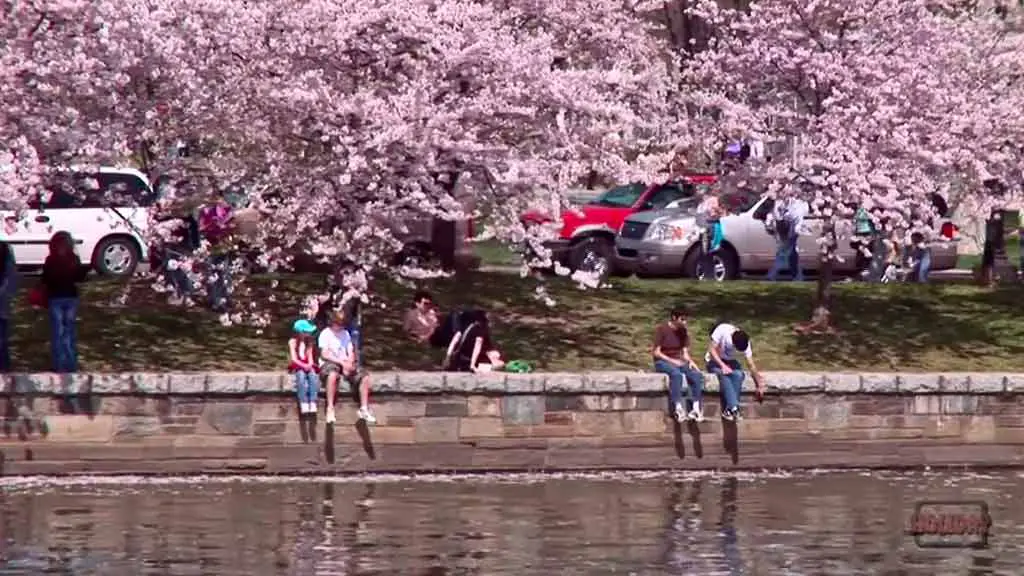Japan gifted 3,000 cherry trees to Washington, DC in 1912, symbolizing friendship and leading to the iconic cherry blossom landscape around the Tidal Basin.
The annual National Cherry Blossom Festival celebrates this gift, attracting millions of tourists to witness the pink and white blooms, highlighting the enduring friendship between Japan and the US.
The festival showcases traditional and modern Japanese culture, drawing visitors from around the world to experience the beauty of the cherry blossoms and strengthening the bond between the two nations.
The cherry blossom trees have become a beloved symbol in Washington, DC, drawing tourists and locals alike to admire their beauty and celebrate the enduring friendship between Japan and the US.
Through the annual National Cherry Blossom Festival, visitors can experience both traditional and modern Japanese culture, further solidifying the bond between the two nations.

Historical Beginnings of Cherry Trees in D.C.
Eliza Scidmore, an American traveler, writer, and photographer, played a crucial role in advocating for the planting of cherry trees in Washington, D.C.
Inspired by the cherry blossoms she saw during her visits to Japan, she envisioned the beauty these trees could bring to the U.S. capital.
Helen Taft, the wife of President William Howard Taft, supported and endorsed the idea of planting cherry trees in Washington, D.C. Mrs. Taft’s interest and enthusiasm paved the way for the eventual gift of cherry trees from Japan.
Her influence and involvement were instrumental in bringing the iconic cherry blossoms to the Tidal Basin.
The Gift from Japan
The arrival of the first cherry trees from Japan marked a significant moment in the history of Washington, DC. In 1912, the Japanese government gifted 3,000 cherry trees to the United States as a symbol of friendship between the two nations.
This gesture cemented the bond between Japan and the U.S., and the legacy of these cherry trees continues to flourish in the heart of the nation’s capital.
The cherry blossom trees were planted around the Tidal Basin and have since become a beloved attraction, especially during the annual National Cherry Blossom Festival.
Visitors flock to DC every spring to witness the stunning pink and white blooms, further solidifying the cherry trees’ significance in the city.
The First Cherry Trees Arrival

In 1912, Washington, DC received a gift of 3,000 cherry trees from Japan, symbolizing the lasting friendship between the two nations. Today, these trees along the Tidal Basin have bloomed into a famous display of pink blossoms, drawing countless visitors each spring.
The National Cherry Blossom Festival annually commemorates the strong bond between the United States and Japan.
The cherry blossoms in Washington, DC have become a prominent symbol not only of beauty and nature but also of the enduring friendship and diplomatic relations between the United States and Japan, attracting tourists worldwide.
Significance of the Donation
The cherry trees donated from Japan to Washington, DC symbolize strong diplomatic ties and cultural exchange, representing peace, friendship, and goodwill between the two nations.
The annual Cherry Blossom Festival in Washington attracts millions of visitors, reinforcing the iconic status of the cherry blossoms in the nation’s capital.
The donation underscores the deep-rooted connection and mutual respect between the United States and Japan, highlighting the trees as enduring symbols of peace and unity that draw crowds from around the world during the renowned festival.
Impact on U.S.-Japan Relations
The gift of 3,000 cherry trees from Japan to the United States in 1912 significantly impacted U.S.-Japan relations, serving as a diplomatic gesture of friendship and goodwill.
Diplomacy Through Flora
The cherry trees gifted by Japan to the U.S. served as a potent symbol of diplomacy, fostering a sense of camaraderie and harmony between the two nations.
This botanical gift transcended mere aesthetics, acting as a living testament to the enduring bond and mutual respect shared by Japan and the United States.
The cherry blossom trees flourished in Washington D.C.’s landscape, attracting millions of tourists annually and solidifying the city’s reputation as the cherry blossom capital of the world.
Post-Pearl Harbor Tensions
Following the tensions ignited by the attack on Pearl Harbor during World War II, the cherry trees in Washington, D.C., stood as poignant reminders of the longstanding relationship between Japan and the United States.
Despite the strained relations during this period, the cherry blossoms continued to bloom, symbolizing hope for reconciliation and peace between the two countries.
The annual National Cherry Blossom Festival held in Washington, D.C., further solidifies the significance of these trees in symbolizing friendship and international unity.
This cultural celebration attracts millions of visitors each year and showcases the enduring beauty of the cherry blossoms.
Cherry Blossom Festival

The Cherry Blossom Festival in Washington, D.C. is a renowned annual event that celebrates the gift of 3,000 cherry trees from Japan to the United States in 1912. Here’s an overview focusing on its inception, cultural impact, and significance:
Inception of the Festival
The Cherry Blossom Festival in Washington, D.C., originated from the generous gift of 3,000 cherry trees from Japan to the United States in 1912.
This symbolic gesture of friendship has since blossomed into a celebrated annual event, attracting millions of visitors from around the world.
The cherry trees, known for their stunning pink and white blossoms, line the Tidal Basin in Washington, D.C., creating a picturesque scene that symbolizes the enduring bond between the United States and Japan.
Cultural and Economic Impact
The Cherry Blossom Festival in Washington, D.C., is a significant cultural event that celebrates the beauty of cherry blossoms and the friendship between Japan and the United States, boosting tourism and local businesses in the area.
The festival symbolizes unity, peace, and shared heritage, stemming from the gift of 3,000 cherry trees from the mayor of Tokyo to Washington in 1912, which now adorn the city’s landscape around the Tidal Basin.
Preservation of the Cherry Trees

The historic gift of 3,000 cherry trees from Japan to the United States remains a significant symbol of friendship between the two nations.
Eliza Scidmore and Helen Taft’s advocacy for planting the cherry trees in Washington, D.C. marked a pivotal moment in the city’s history, enhancing its landscape and embodying peace and goodwill between Japan and the U.S.
This enduring bond was particularly poignant during post-Pearl Harbor tensions in World War II, where the cherry blossoms in D.C. served as reminders of hope for reconciliation and peace.
Restoration Efforts
Efforts to preserve and restore the cherry trees in Washington, D.C. are paramount to maintaining their cultural and historical significance.
Preservation initiatives focus on protecting the trees from diseases, pests, and environmental stressors to ensure their longevity and vitality.
Regular pruning, nutrient management, and monitoring for any signs of distress are essential components of the restoration efforts to safeguard the iconic cherry blossoms for future generations.
Current Challenges
The cherry trees in Washington, D.C. are at risk due to climate change, urban development, and pollution, which can hinder their ability to bloom successfully and affect their overall health.
To safeguard these trees and maintain their significance, a comprehensive strategy involving sustainable urban planning, environmental preservation, and public education is required.
By implementing proactive measures such as proper tree care, regular monitoring for diseases, and supporting local conservation efforts, we can help ensure the longevity and resilience of the cherry trees in Washington, D.C.
Such efforts will be crucial in preserving these iconic trees for future generations to appreciate and enjoy.
Frequently Asked Questions
What is the historic significance of the cherry trees in Washington, D.C.?
The cherry trees in Washington, D.C. were a gift from Japan in 1912 symbolizing enduring friendship between the two nations. They enhance the city’s history and serve as reminders of unity and cultural exchange.
Why is the preservation of the cherry trees important?
Preservation efforts are vital due to challenges like climate change and urban development threatening the trees’ existence. The cherry trees symbolize lasting friendship between the U.S. and Japan and are integral to the nation’s capital.
What event evolved from the gift of the cherry trees and its significance?
The Cherry Blossom Festival evolved from the gift of cherry trees, becoming a significant annual event attracting millions and boosting tourism. It emphasizes the lasting friendship between the U.S. and Japan.
Conclusion
The cherry trees in Washington, D.C., symbolize the enduring friendship between the United States and Japan, beginning with their gift in 1912 and continuing through the annual Cherry Blossom Festival.
The festival serves as a celebration of unity, cultural exchange, and economic impact, emphasizing the importance of preserving these trees against modern challenges like climate change and urban development.
It is crucial for stakeholders to maintain the cultural and historical significance of the cherry trees, ensuring their continued existence and symbolic value in promoting harmony between nations.
With their iconic pink blossoms, the cherry trees attract thousands of visitors each year, further solidifying their importance in the cultural landscape of Washington, D.C.
The legacy of these trees reinforces the bond between nations and highlights the need for conservation efforts to protect their symbolic value for future generations.




Allison Brice